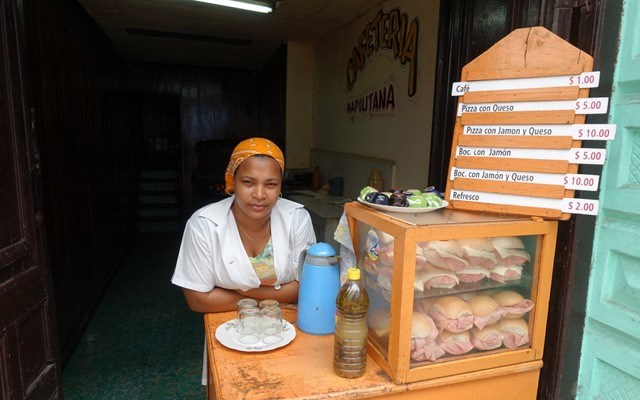Fifty years in isolation is a long time. It's a long, long time for a person, but even longer for an entire nation.
With Presidents Barack Obama and Raul Castro leading the charge for normalizing the relationship between Cuba and the U.S., all bets are off as to how the island nation will change — and that includes the local cuisine.
Big steps are already underway, but the actual lifting of the trade embargo is going to take congressional approval, and who can say when that will happen. In the meantime Canadian travel agencies are swamped with customers who want to see the "little" island — not so very little with nearly 6,000 kilometres of coastline — before the U.S. invasion, and you know the kind I mean.
If you haven't been lucky enough to visit Cuba yet, give it a thought or three. There's much to be said for a nation on this planet with no McDonald's, no SUVs, no Home Depots, no Starbucks. The lack of fast and/or shiny objects has fostered some beautiful things, including an incredible arts community, tragically crumbling architecture, and a multi-valence cuisine and food system so unique it's worth going for those alone.
Maybe the first thing you think of when it comes to Cuban food is Moros y Cristianos, the mainstay made from black beans and rice (see recipe below). The full name, which translates as "Moors and Christians," refers to the dark-skinned Moors, who invaded the Iberian Peninsula in the early 700s from Africa, and the light-skinned Christians, who, after hundreds of years, eventually took back what's now called Spain.
But while Spanish influence is the most obvious cultural thread in Cuban cuisine, it ain't the only one. The influence of the Taíno-Arawak, the indigenous people of Cuba and all the Caribbean, comes through with chili peppers, starchy yuca (or cassava or manioc root), calabaza (West Indian pumpkin) and corn, especially corn. In fact, the Taíno-Arawak introduced corn in its many forms — boiled, roasted, ground into flour — to Christopher Columbus and the rest of Europe. More important introductions: the name "Cuba" comes from the Taíno language, as do "barbecue," "tobacco," "hammock" and "hurricane."
Once the Spanish got established on the island, slaves were brought over from Africa. Their culinary influence ran deep because they were literally running the kitchens on the big plantations. They were so big on black beans and rice that Moros y Cristianos may well have come from these plantation kitchens. Another big African touch: plantains. Get them deep-fried from street vendors or just about anywhere, including the family-run eateries, called paladares, where you literally dine in somebody's home and feel like you've "discovered" the "real" Cuba.
With all those kilometres of coastline, it's only natural that every cultural thread uses seafood, especially the Portuguese, who eventually migrated along with the Spanish, bringing their unique touches such as salt cod and rich soups and stews, along with that most delicious custard-like Cuban dessert with not a stitch of bacon in sight, Tocinillo del Cielo (it often gets mistakenly called Bacon from Heaven).
Then you've got the French influence from the plantation owners who fled to Cuba from Haiti, the Mexican/Latin American touch with things like burritos and churros, and the Chinese influence from the 100,000+ Chinese workers brought to Cuba in the mid-1800s for work, often as alternative labourers by plantation owners fearful of slave uprisings. A little Five Spice here, a few stir-fried veggies there...
And while you're talking about "food" and "Cuba," you can't leave out the one big thing that forever changed the "little" island nation: sugar cane. For it was when sugar prices soared after the First World War that Bacardi rum and all the other delights of big money — casinos, mansions, corruption — took off, leading to The Big Revolution and the unique Cuban society of today.
It's tough to say just how the country will be impacted once things open up. Cubans like Gerardo Hernández, one of the freed Cuban Five heroes who recently spoke in Vancouver, assure the world, don't worry. Cubans are smart and strong and resilient; they know what they're doing. They are also extremely kind and authentic. You can't be otherwise after 50 years of more or less going it alone. But still...
One thing you might want to put your money on, though, is their cuisine. After centuries of outside cultural forces getting gobbled up as per the quick romp above, I'd say cocina Cubana has a good shot at not just surviving, but flourishing.
In the meantime, here's an easy recipe that delivers a classic taste of Cuba at home.
Moros y Cristianos (From A Taste of Cuba, by Linette Creen)In a large pot, heat 2 tbsp. olive oil over medium heat. Add 1 medium onion, diced; 2 garlic cloves, crushed; and 1/2 c. chopped green pepper. Sauté about 5 minutes. Add 2 medium tomatoes (peeled, seeded and chopped), 2 c. cooked black beans, 1 c. chicken stock. Simmer for about 5 minutes stirring frequently until heated through. Add 1 c. long grain white rice and 2 c. water (we use less). Cook over low heat, stirring occasionally until the rice is tender and the liquid absorbed, about 15-20 minutes. Add salt and pepper to taste. Serve hot.
Glenda Bartosh is an award-winning journalist who still smiles about her Cuban adventure.




